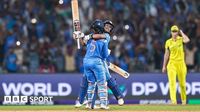The buzz around Indian women’s cricket has reached a fever pitch as the nation’s team stormed into the ICC Women’s World Cup 2025 final, setting off celebrations across the country and sending a powerful message about the growing influence of the women’s game. But as the excitement builds for Sunday’s title clash against South Africa at Navi Mumbai’s DY Patil Stadium, the journey to this historic moment has been anything but ordinary—marked by record-breaking performances, viral internet mischief, and conversations that reach far beyond the boundary ropes.
The drama began not on the pitch, but online. On October 31, 2025, eagle-eyed cricket fans noticed something odd on Wikipedia: the result of the upcoming World Cup final had been posted days early, showing India triumphing over South Africa by a whopping 100 runs. The entry even included fabricated match stats—India allegedly racking up 326/5 in 50 overs and bowling out South Africa for 285 in 43.4 overs. But there was a glaring problem: the run difference was actually 41, not 100, revealing the post as a hasty prank. Wikipedia’s open-editing model had allowed the mischief, but vigilant editors quickly moved to correct the error, reminding everyone that the real action was still to come on Sunday at 3pm IST.
While internet antics provided a brief distraction, the cricketing world remained firmly focused on India’s sensational semi-final victory over Australia—a result that sent shockwaves through the sport. On October 30, under the bright lights and in front of 35,000 roaring fans at DY Patil Stadium, India pulled off the highest successful run chase in Women’s World Cup history, chasing down a daunting 339-run target to defeat the defending champions by five wickets. It was a night when history was rewritten, and the crowd’s jubilation was matched only by the pride of a nation watching from millions of screens.
At the heart of this epic chase was Jemimah Rodrigues, whose unbeaten 127 will be remembered as one of the all-time great innings in women’s ODI cricket. Rodrigues, who just days earlier had been left out of the starting eleven, delivered under immense pressure. Each run was met with a deafening roar, and when Amanjot Kaur struck the winning boundary, Rodrigues collapsed to the turf, overcome with emotion. In the post-match news conference, she revealed, "I cried almost every day of the World Cup with anxiety." Her grit and determination shone through, transforming her from a star to a national icon with a chance to etch her name in sporting folklore.
The semi-final itself was a rollercoaster. Australia, powered by Phoebe Litchfield’s 119 and half-centuries from Ellyse Perry and Ash Gardner, posted an imposing 338. At the halfway mark, Australia’s eight-year unbeaten run at 50-over World Cups seemed destined to continue. But India, buoyed by Rodrigues’ brilliance and a fearless approach, turned the tide. Fielding lapses by Australia—rare for such a clinical side—added to the drama, and the hosts seized their opportunity with both hands.
The cricketing fraternity erupted in praise. Sachin Tendulkar tweeted, "Fabulous victory!" while Virat Kohli called it "a true display of resilience, belief, and passion." Isa Guha, former England international, declared, "Jemi Rodrigues - that was unbelievable. One of the greatest knocks you will ever see." The sentiment was echoed by legends like Mithali Raj, VVS Laxman, and Sourav Ganguly, who lauded the team’s heart, hunger, and historic achievement. Michael Vaughan, former England captain, summed up the mood: "Any team that beats Australia deserve to win the WC."
But the impact of this victory extends beyond the scoreboard. As former IPL batter Abhishek Jhunjhunwala told BBC Test Match Special, "The pace at which women's cricket is growing in India is unbelievable. Girls have started playing on the streets with boys, which you never used to see. They want to be a Jemimah Rodrigues or a Deepti Sharma." The Women’s Premier League, launched two years ago, has already begun transforming the landscape, offering women financial independence and new societal roles. The World Cup run has only accelerated this shift, inspiring a new generation and drawing unprecedented crowds—men and boys included—wearing the names of Smriti Mandhana and Harmanpreet Kaur.
Yet, the journey for women in Indian sport is not without its challenges. In the days following the semi-final, news broke that two Australian players were sexually harassed while walking in Indore, Madhya Pradesh. The swift police response led to an arrest, but the incident sparked a wider debate about women’s safety in India and the everyday obstacles female athletes face. Comments by a local minister, suggesting the players were at fault for venturing out alone, drew sharp criticism and highlighted the persistent societal attitudes that women must navigate—on and off the field.
Authors Shilpa Ranade and Sameera Khan, co-creators of the "Why Loiter?" campaign, have long argued that women in India are forced to meticulously plan their movements in public spaces, rarely enjoying the freedom to simply linger or play. Cricket, as India’s most popular sport, has become an unlikely but powerful platform for change. The visibility and success of players like Harmanpreet Kaur and Jhulan Goswami, both single and fiercely independent, challenge traditional expectations and inspire women to carve out their own paths. As Mithali Raj once said, "Financially, emotionally, everything, I don’t have to depend on a man for anything. I can really stand up on my own."
With the final against South Africa looming, anticipation has reached a crescendo. For the first time since 2000, a new champion will be crowned—neither India nor South Africa has ever lifted the trophy. South Africa, fresh from a commanding 125-run win over England, are making their first-ever appearance in a Women’s World Cup final, adding another layer of history to Sunday’s showdown.
As the world watches, the stakes go far beyond silverware. An Indian victory on home soil could catapult women’s cricket to new heights, both in terms of reach and commercial investment. The momentum is undeniable, and the message is clear: women’s cricket is here to stay, and its brightest days may still be ahead.
For now, all eyes are on DY Patil Stadium, where dreams will be realized, barriers will be broken, and a new chapter in cricketing history awaits. The final whistle hasn’t blown yet, but whatever the outcome, this World Cup has already delivered unforgettable moments and ignited a movement that shows no signs of slowing down.





